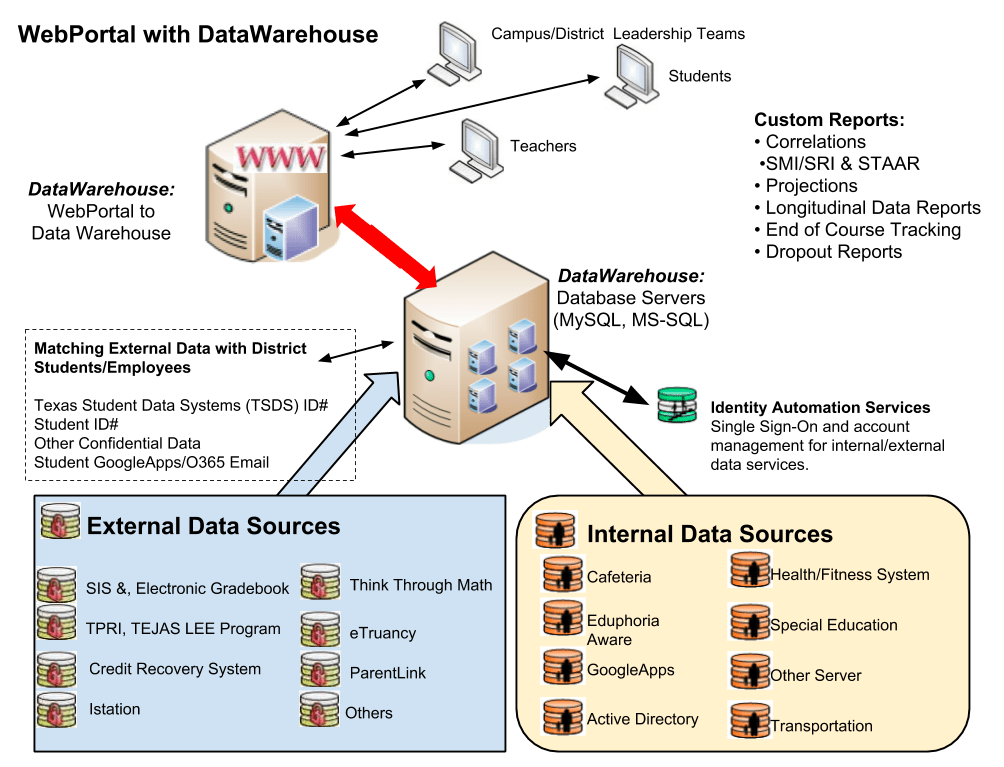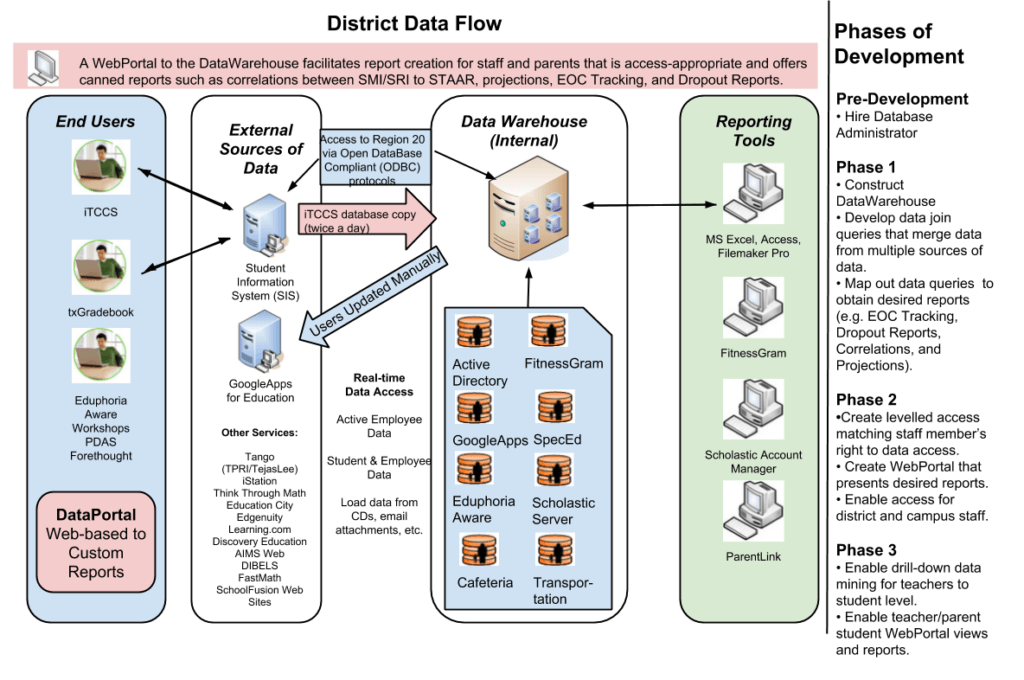Can your district recognize patterns in student achievement data and then craft appropriate instructional interventions? Many districts have a clear and urgent need to do so. The problem is that they don’t know it. Achieving the technical reality can be difficult to grasp for top leadership. In this blog entry, we’ll explore some of the reasons why a data warehouse can be helpful.
Web Portal with Data Warehouse
When I first proposed the need for a data warehouse, the district I served thought what they had was sufficient (e.g. Eduphoria Aware). One reason was that they didn’t know how many systems needed to interact with each other. For each system, a manual process was involved. The image below captures some of the various data systems that needed to interact with each other. See if this looks familiar to you.

Conversations with school leadership staff soon revealed that they spent weeks combining various data sources (e.g. assessments) into spreadsheets. Unfortunately, these spreadsheets were prone to errors and seldom resulted in swift instructional interventions that impacted teaching and learning. Worse, district leadership didn’t know what they did not know. They did know that digging up, reviewing, and crafting data reports manually took time. They didn’t realize that campus staff spent weeks doing it.
One of the challenges was identifying the steps to go forward. The initial journey was imagined to take about six months. However, the process took a full year with constant interventions. The main obstacles? Getting the district’s internal systems exporting the data to match the required schema, as well as getting the various vendors to work together (e.g. Student Information System (SIS)).

Once district leaders understood the potential of a data warehouse with a web-based data dashboard, they decided to move the project forward. One way of helping them understand involved collecting scenarios from various stakeholders.
Scenarios
Here are a few scenarios that illustrate why a data warehouse is needed:
- Due to ELA Reading and Writing scores being combined, campuses will need to know if a student met minimum composite scores and ascertain minimum section scores. To effectively track students for End of Course retesting, we need to know two collections of data:
- Student information (e.g.ID#, first year enrolled in high school, first year in a Texas high school, and testing results (three tests per year per subject). This data is combined with…
- Combined ELA Reading and Writing scores. This spring, the ELA tests will be combined. The district will need to know if the student met a minimum composite score and a minimum score for each section. This information is then compiled to determine who needs retesting.
- A need exists to evaluate special education services. Six components of information that need compilation and juxtaposition include the following: level of inclusion, modifications, accommodations, nine weeks test scores, and STAAR results, all listed by teacher.
- A teacher needs to complete a report about AVID at his school. He needs to know student performance in AVID as compared to other students. One piece of information he needs is the percent of students that drop Pre-AP classes.
- List of students to test for gifted and talented. The campus staff person begins with a basic list from SMI/SRI scores. Then the staff person goes into Aware to look at quarterly assessment scores, STAAR scores, and then into Texas Gradebook to look at grades. The campus staff person has to look at 45 different students to gather the data. The process is repeated each time a list of students needs to be tested for gifted and talented. It can also involve greater numbers of students.
- When beginning the RTI process, teachers must complete a Review of Student Records form. Teachers must pull attendance data, previous intervention data, screening data, and possibly others as well like grades. In the past, many teachers have even called in sick so that they could complete these forms. In most cases, it took several hours to gather the data prior to even compiling it on the forms.
- A need exists to pull data from the following: iStation, SAM, ALEKS, Think Through Math, Tango, AIMs Web, and Eduphoria. Current practices involve going into each program individually and then extracting data from each to compile.
Even More Scenarios
Wondering about some other possible reasons for a data warehouse from a special programs perspective?
- Bilingual/ESL Office: TPRI/TejasLee staff and student data exports have to be obtained via a single district person and this can involve wait time.
- Special Education: Both district and campus staff have to correlate data between iTCCS and vendor systems–whose disparate systems are unable to “talk to each other”–to get the results needed to serve special populations.
- Technology: To assess the implementation of digital devices and their impact on instruction, it would be wonderful to query and generate reports. Data needed includes student attendance (comparing one classroom to others), individual attendance reporting, student achievement across grade levels, individual performance, and discipline referrals.
If these scenarios are familiar to you, a data warehouse may be the solution to your problem.
Data Warehouse Next Steps
The goals of establishing a data warehouse include the following:
- Facilitate easy, safe, and appropriate access to data that campus and district staff need to accomplish essential job functions, and
- Eliminate time that the staff currently waste in data hunting-and-gathering, sifting, and organizing that consume more time than the data analysis component requires.
- Enable staff to have tiered levels of access to generate reports derived from data critical to their job functions via a web-based interface to a data warehouse of content.
The end result is a more informed leadership and better decision-making in service of students and staff. To achieve that, your district will need to make a plan. In part two of this blog entry, we will explore a sample plan you can customize for your own district.

